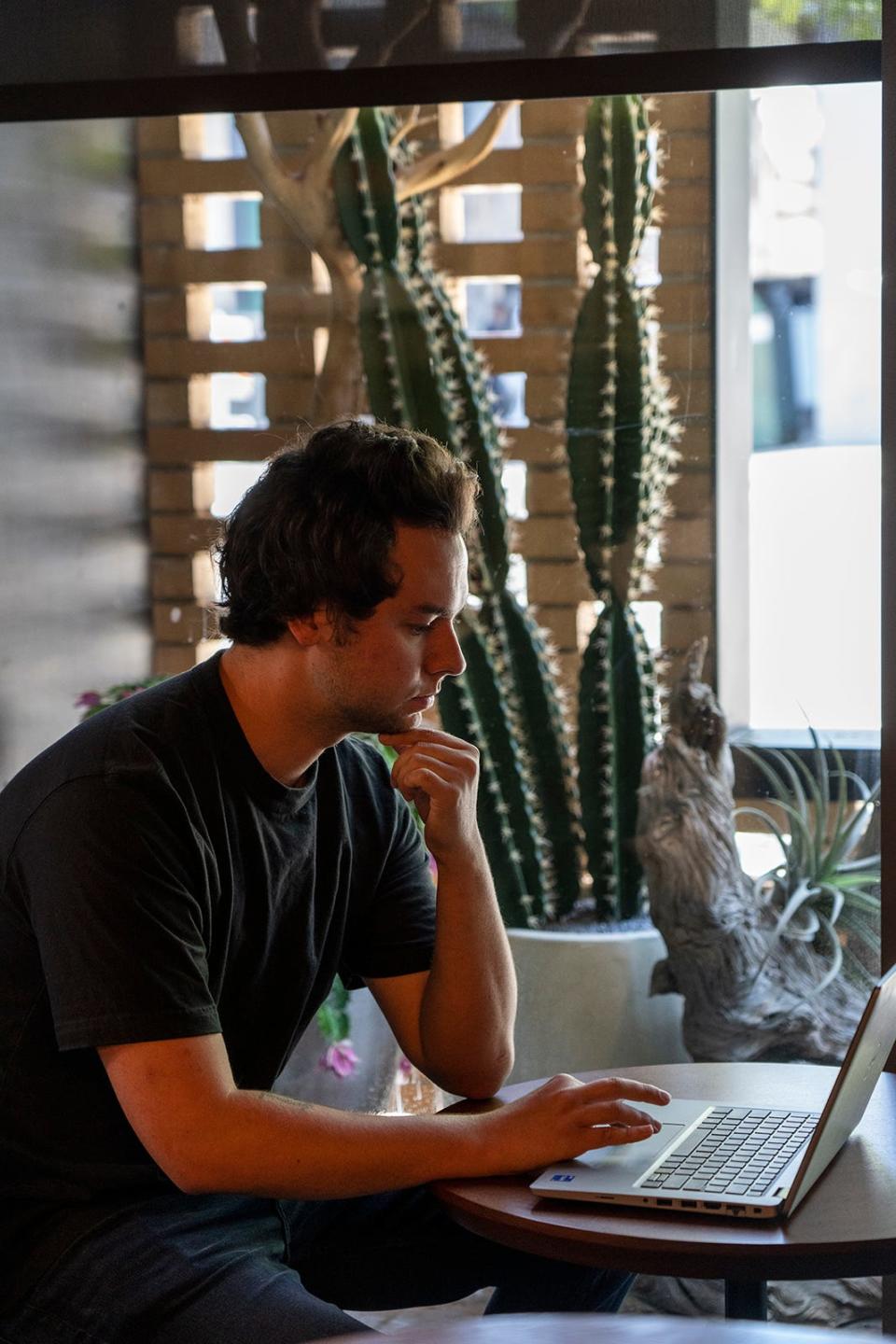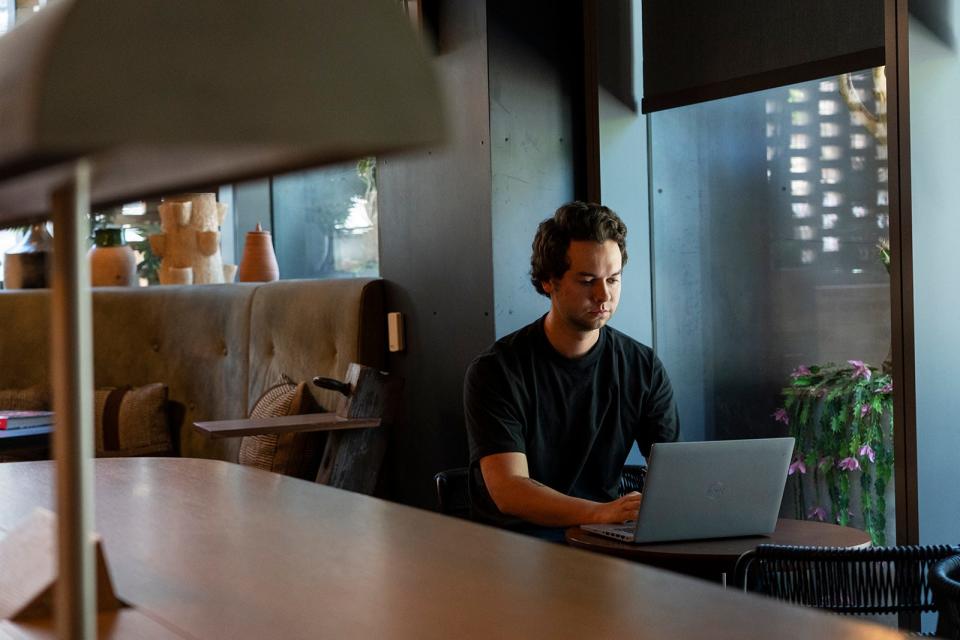Austin companies are pushing for a return to office, but is remote, hybrid work here to stay?

Weston Sabattus always thought it would be nice to work remotely, but, as someone who worked in the oil and gas industry in a traditional office setting, that had seemed unlikely.
But when the coronavirus pandemic hit, it gave him the opportunity to shift his work environment to home. Sabattus, who moved to Austin in the summer of 2020, and now runs Plymouth Wright, an accounting and bookkeeping service, has no plans to return to an office setting. While he does have access to a small space in a WeWork office, a coworking company that offers businesses and individual members flexible access to workspaces, staying remote makes the most sense for his small business, even as some of the company's tech clients return to their offices.
“It's definitely most cost effective. Unless you have a business model where everyone needs to be in person, it doesn't make sense right now,” Sabattus said. "I don't see any point in requiring someone to come into the office."
National conversations around the benefits of returning to an office, or whether to continue offering a hybrid or remote work environment, have been seemingly never-ending in recent years, as an increasing number of companies are asking workers to return to office buildings after many were sent to work from home during the pandemic.
Locally, decisions made by employers are having a broader impact on the state of downtown Austin – including the health of the area's office space market, its residential rent prices and its restaurants and entertainment venues.
There are fewer jobs requiring 40 hours per week in an office than there were pre-pandemic, driving down demand for office space among employers. But in Austin, unlike some metro areas, the desire to live downtown remains so strong that rent prices and occupancy rates still seem exorbitant to some.
Exploring some of these effects, the American-Statesman spent time with several professionals who call Austin home, even if they might not keep formal office hours in the city, and talked to experts who explain why Austin businesses – particularly big technology – could serve as a bellwether for the new standard in future work norms as some employers attempt to wrest workplace control back.

Flexibility remains highly desired even as companies call people back
Alan Grinberg, a software engineer for GM, had worked fully remote for several years before transitioning to a hybrid work schedule that requires him to spend two days a week in the office. Prior to the pandemic he worked in sales, full-time in person.
“As someone who initially, before going back to school, mostly worked in in-person environments, it's been freeing to get the things done that you need to get done for work, and still have the freedom to take care of life at the time of that as well," Grinberg said. "Having that capacity versus being inside an office every day has definitely been helpful. I can find a nice balance between the work and life."
In October 2020, Grinberg moved to Austin from Seattle primarily for his new job, where lower-priced Austin meant he could afford his own apartment. Now that he's back in the office, his team decides when they come in during the week, and, aside from the quibbles over the days of the week, it's still pretty relaxed, and he finds he can go in and out as needed, and there's not too much pressure on being in the office.
“I feel more productive when I'm in the environment that I'm most comfortable, and it's not always the same day to day,” Grinberg said, explaining, that being in an office for tasks like calls doesn't make sense to him.
Grinberg said at this point it would be very tough to go back to spending every day at the office with a 9-to-5 setup and hopes hybrid and remote work stays the norm.
“If I were to go elsewhere, I would probably look for either the same hybrid setup or fully remote,” Grinberg said. “I want to be able to live the lifestyle I want, and having the flexibility I want, while hopefully retaining competitive pay as possible down the road.”
A desire for flexibility is still top of mind for workers like Grinberg and Sabattus, many of whom remain on a hybrid or remote schedule.
According to a 2022 Pew Research Center report, 78% of workers who were currently working from home all or most of the time said they would like to continue.
But as of 2023, a separate Pew report found that only 35% of workers with jobs that can be done remotely are working from home all the time, down from 43% in January 2022 and 55% in October 2020. The report also found that most hybrid workers would prefer to work from home more than they currently do.

'No right answer' for workplace models right now
Thom Singer, CEO of Austin Technology Council said “there’s no right answer” and what work environment works best largely depends on the individual organization.
“Flexibility and hybrid seems to be what's winning. There definitely seem to be a lot of companies who would like people back in the office for culture reasons," Singer said. "But a lot of people don't want to come back five days a week, and so, there definitely seems to be a compromise around either hyper flexibility or a hybrid schedule."
Singer said there are a lot of Austin companies that have gone fully remote and are happy with the way it's working, while others aren’t happy with the productivity and culture of remote work and are looking to bring people back to the office. Some jobs are more collaborative and might benefit from meeting in a conference room with a whiteboard, while others can be just as easily done remotely as they can in-office, he said.
"I think this is going to take years to figure out, and that's OK,” Singer said. “It's up to the individual company, how they want to structure it. Some people like going into the office every day, some people don't want to, and I think it will all shake itself out in the long run. If people think there is a right way to do it, that's not realistic.”
He predicted the “big winner” of the return to office conversation will be increased flexibility no matter the company, for issues like child care, repairperson visits and travel opportunities, as long as work is getting done.

Big Tech could set the tone
Dan Ives, a technology industry analyst, said there's been more of a shift to have employees back in the office in recent months, largely through hybrid work plans, a trend he expects to continue.
"We've definitely seen the clock strike midnight on 'wearing sweatpants doing your work from home whenever you want environment,'" Ives said. "When you have the top tech companies in the world doing it, it sends a signal."
Some companies with large Austin presences, including Google, Twitter and Meta, have reversed more flexible work from home policies, instead requiring workers to be back in the office most days of the week. Elon Musk, CEO of Austin-based Tesla and SpaceX, and owner of Central Texas-based Boring Co. and Twitter, has notably required workers to return to the office full time.
Google, which requires its employees to be in three days a week, started tracking badge swipes and has said it will affect performance reviews.
Apple and Meta are similarly tracking badge swipes, and, earlier this summer, Salesforce, tried to nudge workers into the office with a policy that donates $10 a day for employees who came to the office between June 12 and June 23.
Roger Kay, a technology industry analyst with Endpoint Technology Associates, said while labor is still in a better position now than it has been for many years, recent waves of layoffs in the tech industry have helped shift the balance of power more towards management again.
“This retrenchment puts the balance of power back in management's hands, and they want to exercise that in some way by saying, 'Come into work,'” Kay said. “You can talk about the uniformity of experience and corporate 'esprit de corps' and people all working together, singing off the same sheet at the same time. But mostly that's not a real thing. It's just a management fantasy."
While different companies have different situations, Kay said tech is probably one of the industries best suited to work remotely, and it even helped pioneer remote work by creating the needed technology.
At the same time, he said, controlling employees has always been part of the status hierarchy of the workplace, and employers might be reluctant to give that up.
“We’ve come full circle on this, because managers like Elon Musk and others really want employees under his thumb and think it's not OK if the employees are enjoying their lives or mixing work with pleasure,” Kay said.
Companies see hybrid and remote benefits too
Abilitie, an Austin-based company that provides companies with leadership development training, had to shift from doing mostly in-person training to fully remote training overnight when the pandemic hit.
But Mathew Confer, vice president of strategy, said the shift was transformational for the company, which has decided to ditch the office space completely, allowing the company to invest those costs elsewhere and hire people outside of Austin. On a day-to-day basis, the employees work from home or coffee shops, and the company aims to get employees together at least twice a year in-person either as a whole or on a department basis.
"The move towards remote work was an accelerator for our business," Confer said. "We actually needed to grow headcount, and that aligned really nicely with our move toward fully virtual for our company."
Confer said the company has tripled the size of its team since 2020, growing from about eight or nine employees to about 35 people, and the company has yet to hear pushback from candidates looking for an in-office environment.
“A bulk of those people that we hired were outside of Austin, so if we hadn't made the move to virtual and remote-first in 2020, I think we wouldn't have been able to scale our headcount internally as fast and as effectively as we did,” Confer said.
The company currently offers both virtual and in-person trainings, with most of its training still happening virtually, though there has been an increase in in-person training in recent months.
"You can tell there's been a push to bring people back together in person," Confer said, but he added that many companies are opting for hotel conference rooms or other off-site locations rather than office spaces.
The shift in remote work has also meant some companies are reimagining their office space. Megan Matthews, head of PayPal's Austin office, said the company moved into a new office in the Domain about a month ago, and, like many other companies, realized work was not going to look the same.
The new office has a mix of regular sit-down desks and a separate "social hub" area with a library and collaborative suite. The company takes a hybrid approach focused around “anchor days” where specific teams are in the office certain days of the week. In Austin, each team decides what their anchor days are. Employees can virtually book conference rooms and desks ahead of time to have dedicated space on the days they come in.
“As a company coming out of a time when everyone was 100% virtual, we didn't know what was going to work. So, we have that luxury to shift things around,” Matthews said. “We've noticed that employees are really excited to be back together. One of my takeaways, as the site leader, really observing some patterns and what people like and what they don't, is there is a hunger for a sense of community and a sense of belonging.”
Current, future employees looking for options
College student Kara Nelson is an intern at Austin-based Planview, which has a hybrid schedule, said once she graduates she would prefer a schedule that has her in an office at least a few days a week or even full time, because she finds it helpful to be in person when she has questions and needs help, especially as some workers do early in their careers. But she said it also has been nice to work from home Mondays and Fridays, when she is able to do stuff at the house as well as work, and ease into the work week and decompress before the weekend.
Jamie Hsu, a designer for Disney on apps, websites and enterprise software, works fully remote from Austin as a contractor and enjoys the flexibility of remote work, said being able to work from home or anywhere has been a game changer.
“I'm quite an extrovert, and prior to the pandemic, when I was working in the office, I'd love to socialize and work with people. I do think that the collaboration aspect in person was huge for me,” Hsu said.
But he wouldn't trade it for the lack of commute and flexibility. His current job, which allows for flexible hours, means he can get chores done during the day and walk his dog several times a day since he doesn't have a backyard. Some days for a change in environment or to focus, he also puts the dog into doggy day care and works in coffee shops.
Prior to the start of the pandemic, Hsu worked in an office in Chicago, but he moved to Austin in May 2021 because his remote job gave him the ability to choose a new city.
“I had that flexibility. I don't need to be tied to a physical location," Hsu said. “I really hated Chicago weather and was there for most of my life, and I want to try someplace new. I've always loved Austin. It was just perfect timing, and the company that I worked for allowed for that.”
Hsu acknowledged that adjusting to a new city while fully remote was hard, and he’s not opposed to working in an office in the future, but he would prefer to work for a company where people have control to choose when, and if, they come in at all.
This article originally appeared on Austin American-Statesman: Austin workers value remote, hybrid work as companies return to office

